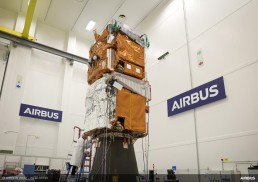May 18, 2022
Final Pléiades Neo Satellites Ready to Join Rest of Family

May 18, 2022
Final Pléiades Neo Satellites Ready to Join Rest of Family



“With this new bold, dispenser-free design, we were able to seamlessly integrate and test these two very high resolution satellites and ensure an optimized launch configuration: in a single launch, we will double the acquisition capacity of the Pléiades Neo constellation, and offer even greater responsiveness to our customers” said Philippe Pham, Head of Earth Observation and Science at Airbus.About Pléiades Neo Comprising four identical satellites, the Pléiades Neo constellation will work hand in hand with the existing Pléiades satellites and the rest of the Airbus Earth observation satellite fleet. The highly compact Pléiades Neo spacecraft have a light weight, next generation silicon carbide optical instrument. They also have laser comms inter-satellite links with SpaceDataHighway (EDRS) geostationary satellites to enable urgent acquisitions in just 30 to 40 minutes following a tasking request to swiftly respond to the most critical situations. To download high resolution images or watch a video extract of the test, please visit our website or YouTube channel.
“With this new bold, dispenser-free design, we were able to seamlessly integrate and test these two very high resolution satellites and ensure an optimized launch configuration: in a single launch, we will double the acquisition capacity of the Pléiades Neo constellation, and offer even greater responsiveness to our customers” said Philippe Pham, Head of Earth Observation and Science at Airbus.About Pléiades Neo Comprising four identical satellites, the Pléiades Neo constellation will work hand in hand with the existing Pléiades satellites and the rest of the Airbus Earth observation satellite fleet. The highly compact Pléiades Neo spacecraft have a light weight, next generation silicon carbide optical instrument. They also have laser comms inter-satellite links with SpaceDataHighway (EDRS) geostationary satellites to enable urgent acquisitions in just 30 to 40 minutes following a tasking request to swiftly respond to the most critical situations. To download high resolution images or watch a video extract of the test, please visit our website or YouTube channel.